"Spetsnaz" tomato with resistance to bad weather and excellent yield: an overview of the variety and nuances of cultivation
We present to your attention a novelty from the selection achievements - the Spetsnaz tomato. Developed by Siberian breeders, the variety embodies a unique resistance to any climatic factors. Its ability to bear fruit in extreme conditions has won the recognition of the inhabitants of Siberia, the Urals and other regions with an unpredictable climate.
The variety is distinguished by large, juicy and fortified fruits with high taste qualities, which will not leave indifferent even the most fastidious gourmet.
The content of the article
Description of the variety
The culture was entered in the State Register in 2017, its author is Vladimir Nikolaevich Dederko, a well-known breeder from Novosibirsk, on whose account there is more than one bred variety. Tomato seeds are distributed by the Siberian Garden agricultural company.
Distinctive features
Indeterminate type, height 1.5-1.8 m, moderate foliage, deep green leaves. Inflorescences are simple, fruiting branches are not branched, 3-5 fruits are formed on each.
Mid-season species, ripening takes place in two waves. The first collection lasts until early August, the second wave lasts until the end of September.
The yield is high, from 1 sq. m are harvested up to 10 kg, provided that 3 seedlings are planted per 1 sq. m.
The culture is not distinguished by persistent immunity to fungal diseases and needs protection from late blight and Alternaria.
Due to the active growth of shoots, regular pinching is required. Also, tall bushes need a mandatory garter, otherwise they will suffer not only from the weight of ripe fruits, but also from gusts of wind or precipitation.
Fruit characteristics
The fruits are large, the average weight at the primary harvest reaches 500-800 g. The secondary harvest gives fruits weighing 200-250 g. The shape is rounded, the color is raspberry-red, the taste is excellent, sweet, with a clear tomato acidity. The pulp is juicy, fleshy, few seeds. The rind is dense, not prone to cracking.
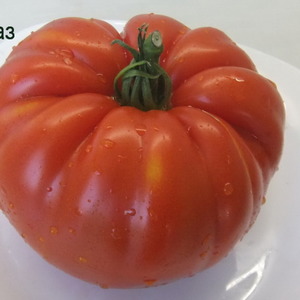
The purpose is universal: they are suitable for fresh consumption and for winter preparations. Thanks to their durable skin, tomatoes are subject to long storage and can withstand long-term transportation.
The photo shows the Spetsnaz tomatoes.
How to grow seedlings
The culture does not belong to hybrid, which means it is possible to collect seeds for sowing on your own. Such seed needs special preparation.
Seed preparation
Seeds are carefully inspected for visible damage, one by one on the table. Grains suitable for sowing must be light in color and free from distortion. Then a saline solution is prepared by dissolving 1 teaspoon of salt in a glass of water. In this way, the seed is checked for internal voids. Grains floating on the surface will not germinate. The remaining seeds are placed in a pink potassium permanganate solution for disinfection. After 20 minutes, they are washed with running water and dried.
To increase the percentage of germination, the grains are soaked in a growth stimulator for 10-12 hours. In addition to specialized drugs, aloe juice, melt water and potato juice are used as stimulants.
Capacity and soil
The soil is prepared from garden soil, humus and peat in equal amounts. A little washed river sand is added to the resulting mixture for ease. After thorough mixing of all components, the soil is disinfected to destroy pathogens. To do this, it is spilled with a hot solution of potassium permanganate or steamed in the oven for 10 minutes at a temperature of 60 ° C. After disinfection, the prepared soil is laid out in planting containers, on the bottom of which small pebbles or sawdust are placed.
reference! The drainage material at the bottom of the tank is responsible for efficient distribution and outflow of water.
You can plant in a common wooden box and in a separate container, for example: plastic cups and peat pots. When sowing in peat pots, the seedlings require minimal maintenance later on.
Sowing
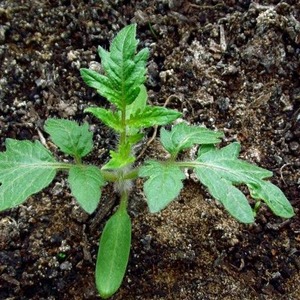 The seeds are sown to a depth of 1-1.5 cm, slightly moisten the soil with warm, settled water using a spray bottle and cover with a film to create greenhouse conditions. The containers are left in a warm room at a temperature of 24-26 ° C, periodically removing the film for ventilation. If necessary, the topsoil is moistened with warm, settled water.
The seeds are sown to a depth of 1-1.5 cm, slightly moisten the soil with warm, settled water using a spray bottle and cover with a film to create greenhouse conditions. The containers are left in a warm room at a temperature of 24-26 ° C, periodically removing the film for ventilation. If necessary, the topsoil is moistened with warm, settled water.
Growing and care
When the first sprouts appear, the planting containers are rearranged on the windowsill. The first week after germination, the temperature is reduced to 18 ° C. With this temperature regime, the seedlings will not stretch and get stronger. After a week, the temperature is raised to 23 ° C. The duration of daylight hours for seedlings is at least 12 hours. With a lack of natural light, phytolamps are used.
Watered moderately, with warm, settled water, along the edge of the nursery with a shallow watering can. After watering, the ground is loosened superficially without touching the young roots.
When 2 true leaves are formed, the seedlings dive, seating them in separate containers. When breeding seedlings in peat pots, picking is not required.
reference! After the picking procedure, the plants develop more intensively.
2 weeks after the pick, the first feeding is performed. Dissolve 20 g of carbamide in 10 l of water and distribute 100 ml to each bush. The second feeding is carried out 2 weeks after the first. In 1 liter of water, dissolve 20 g of nitrophoska.
reference! The main active substance of urea is nitrogen, which is necessary for the full growth of seedlings.
2 weeks before planting in the ground, the seedlings are hardened, taking them outside for 1-1.5 hours at a temperature of 16 ° C. The time interval is gradually increased to 12 hours, while the night temperature in the room is reduced to 13 ° C.
How to grow tomatoes
After 2 months, the seedlings are ready for transplanting into the ground. By this time, 1 inflorescence has been formed on the bushes.
Landing
The wells are prepared a few days before planting, pouring plenty of water over them. A little mineral fertilizers or wood ash is preliminarily placed on the bottom.
Planting pattern: 60 cm - the distance between the seedlings, 65 cm is left between the rows. For 1 sq. m place no more than 3 plants.
They are transplanted on a cloudy day or in the evening, the holes are compacted, watered with warm, settled water and the seedlings are left to get used to the new conditions for 1 week.
Further care of the tomato Spetsnaz
Regular watering set 2 times a week, initially pouring warm, settled water under the root. When the ovaries are formed, the amount of watering is increased, since the plants need more moisture. But there is no need to create an excess of moisture in the beds, this will negatively affect the root system and the taste of the forming fruits. After watering, the soil is loosened, removing weeds with roots.
To retain moisture in their beds mulch straw. Mulch not only protects the soil from drying out, but also serves as a preventive measure in the fight against terrestrial insect pests.
The culture is responsive to fertilizing. She is regularly fed with complex fertilizers.
2 weeks after transplantation, fertilize with mullein infusion in a ratio of 1:15. 500 ml of solution is consumed under each bush.
When the second brush blooms, plants are fertilized with chicken droppings in a ratio of 1:15 and 25 g of potassium sulfate diluted in 10 liters of water. The resulting solution is consumed under each bush 1 liter.
During the flowering of the third brush, they are fed with a full complex of mineral fertilizers in an amount of 1 liter for each plant.
reference! All dressings are applied after watering.
Features in care and possible difficulties
When planting in the ground, immediately next to each bush, a wooden or metal support is installed, to which the stem is fixed. This technique helps the young stem to grow stronger and form even more quickly. As the fruitful branches grow, they are also fixed to the support.
Another option garters - fixation of plants to the trellis. For this, supports are installed from different sides of the beds, between which a wire is horizontally pulled. The stem and branches are tied to the wire with soft ribbons. This type of garter is the most convenient because the soft fabric does not harm the plant.
Culture needs regular pinching due to the large number of shoots. It is recommended to remove stepchildren who have reached 4-5 cm. If you remove a shorter length, new ones will appear immediately.
Plants lead in 1-2 stems. This is the most optimal option for obtaining the maximum fruiting rate.
After harvesting the primary harvest, the tops of the bushes are pinched, thereby accelerating the appearance of new ovaries.
Diseases and pests
Tomato is especially hardy to weather extremes, but not too resistant to fungal diseases. One of his worst enemies - late blight... When it is damaged, most of the plantings die, therefore, preventive measures when growing tomato are especially necessary.
Prevention includes:
- moderate watering with control over the state of moisture in the beds;
- systematic loosening;
- weed removal;
- mulching the beds;
- treatment of plants with fungicides;
- ventilation of protected structures.
Before planting tomatoes, the ground is spilled with a hot solution of potassium permanganate and treated with copper sulfate to destroy fungal spores.
In the fight against late blight, a fungicide of systemic action "Fitosporin" or "Hom" is used.
To protect the crop from insect pests, plants are treated with insecticides or infused with decoctions of various pungent-smelling herbs. The use of chemicals is possible only before the beginning of flowering, folk methods help out throughout the growing season.
Colorado potato beetle is harvested by hand, carefully examining each bush from different sides for the presence of a pest. Pheromone traps are installed from the whitefly, which capture only parasitic insects, without harming the rest. Also, to scare away pests from the beds next to the tomatoes, pungent-smelling herbs are planted, for example: calendula or mustard.
Nuances for open ground and greenhouse conditions
Greenhouse bushes grow up to 1.8 m, while in open beds their growth does not exceed 1.5 m... Do not forget that in greenhouses, the level of humidity is often increased, which contributes to the rapid spread of fungal infections. To avoid diseases, the greenhouse is ventilated on a daily basis, without creating a draft. A regular supply of fresh air destroys the habitual habitat of many greenhouse pests.
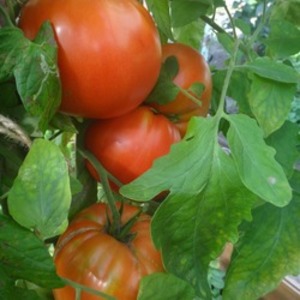 To increase the mass of fruits, only 1 or 2 ovaries are left in the lower fertile clusters. With this method, it is possible to get vegetables weighing up to 1 kg.
To increase the mass of fruits, only 1 or 2 ovaries are left in the lower fertile clusters. With this method, it is possible to get vegetables weighing up to 1 kg.
The seeds for the next planting are taken mainly from the fruits from the second cluster. It is in these vegetables that the seed material maximally preserves the properties of the parental genes.
The distance between greenhouse bushes during transplanting should be greater than in open beds, otherwise the plants will not receive enough light. In addition, thickening of the plantings is possible, which will lead to the development of infectious diseases.
Harvesting and application of the crop
The first vegetables are harvested before the beginning of August, preparing the plants for the second wave. For the second time, vegetables ripen by September, but their sizes are already smaller.
reference! Double fruiting is a special achievement of modern breeding, successfully embodied in the Spetsnaz variety.
The purpose of vegetables is universal, although the variety belongs to salad. They are used to prepare a variety of fresh dishes: hot, vegetable, summer salads, various snacks, pizzas.
For preservation, smaller tomatoes are used, collected a second time. They also go to the preparation of pickles and marinades. Tomatoes are used for processing for tomato products, getting excellent juices, pastes, ketchups, adjika.
Ripe vegetables can withstand long-term storage and transportation.
Advantages and disadvantages
The main advantage of tomato is double fruiting. In addition, culture has a number of other advantages: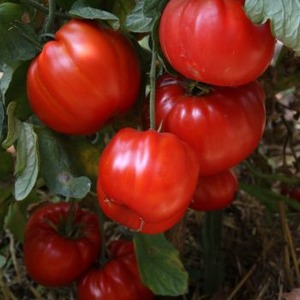
- unpretentious care;
- cold resistance;
- fruit setting in any conditions;
- high rate of fruiting;
- takes root in all regions;
- excellent taste;
- large fruits;
- versatility in cooking;
- long storage;
- long transportation;
- the possibility of self-selection of seeds.
Of the negative sides are:
- garter required;
- regular pinching;
- average resistance to disease.
Farmers reviews
Most of the reviews about the new variety come from Siberia. Gardeners celebrate excellent taste and large-fruitedness even during the short and rainy summer season.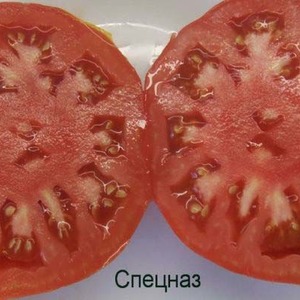
Roman, Omsk region: «I planted some spetsnaz bushes. On the seed bag it was written that you can get a double harvest. And so it happened. At the very beginning of August, he took off all the large fruits, and by September many more, only smaller in size, had grown. The tomato convinced with its firmness, despite the bad climate. "
Nadezhda, Altai Territory: “I planted the tomato in the greenhouse. During the growing season, it gave a lot of organic matter. The fruits have reached a weight of 400-600 g. Excellent taste, good yield. I will definitely continue to grow. The seeds were harvested from the largest tomatoes of the first wave. "
Conclusion
So, you have met a novelty in the Siberian collection - the Spetsnaz tomato. Only 2 years have passed since the appearance of the variety, but despite the short period of existence, the tomato is confidently gaining the ranks of fans.
Reliable characteristics, high yields, simple agricultural technology, adaptation to any weather conditions and convincing photographs make every gardener want to try the new product on their beds.